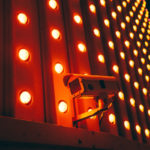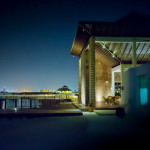Types Of Night Vision Security Cameras
Security cameras with night vision are crucial for monitoring your property around the clock. Night vision technology allows you to capture usable images in low to no light conditions. This is extremely helpful as most burglars prefer to lurk around in the darkness.
Whether you are safeguarding your home or business, night vision security cameras are a great investment. Before you start shopping, review the different types of night vision to decide which will work best for your surveillance needs.
Low Light Night Vision
Low light night vision is also known as image intensification as it relies on image intensification technology to deliver colored night vision in very low light. Please note that in order to produce a color image, these security cameras need some available light.
Low light night vision cameras use an image intensifier which is a vacuum-tube based device. Electrons are emitted through a vacuum tube when the light strikes a charged photocathode plate. These electrons then strike the microchannel plate that cause the image screen to illuminate with a picture in the same pattern as the light that strikes the photocathode (on a frequency that the human eye can see). The image is said to be “intensified” because the output visible light is now brighter than the incoming light.
Benefits
- Despite needing some visible light in order to record, low light night vision cameras outperform IR night vision cameras.
- These are the only security cameras that can produce a color image in low light level conditions.
- You can find these cameras at cost-effective prices.
Infrared (IR) Night Vision
These days, most security cameras come with built-in infrared LEDs to provide night vision in low light or no light conditions. One of the most important features of these cameras is the infrared cut filter or infrared cut removable.
The IR cut filter is a mechanical shutter design – it is a piece placed between the lens and the image sensor, controlled by a motor or an electromagnet. These are used with color CCD or CMOS cameras to produce accurate color images.
When IR cut filter is activated, it will block IR light and allow only visible light to pass through. When the ICR is turned off, IR light will be allowed and images will turn into black and white mode.
If it’s controlled by a light sensor, at twilight, it simply sends a remove signal to the IR cut filter so that more light could reach the image sensor of the camera, thus, a black and white image is produced.
It is important to know that IR security cameras can be affected by glass reflection or window glare at night. Your video may be washed out due to overexposure of lights at night. If necessary, turn off the IP LEDs and any other LED indicators on your security camera.
Benefits
- Infrared night vision cameras can record in pitch black condition without additional light.
- These cameras are the most inexpensive, use less energy, and are very efficient.
Thermal Night Vision
Thermal night vision cameras have a unique lens that allows IR energy to pass through it. The focus light then hits a sensor that scans the information and draws from several thousand points in the field of view. This process creates a thermogram (an intricate temperature pattern) which quickly develops and then transforms into electric impulses, which are directed to signal processing unit that translates the information into data for the visual.
Created image displays as various colors that correlate to the amount of IR energy emitted. Instead of intensifying light, thermal night vision uses heat and can see no matter the light level. Thus, even in total darkness and poor weather conditions, thermal imaging technology allows users to detect and see at great distances.
Benefits
- Thermal cameras are the only solution to address a visible image contrast to see at night.
- As mentioned, these cameras are completely immune to smoke, dust, and anti-CCTV surveillance devices (visor glasses, infrared laser glasses).
- Government agencies, security companies, and large corporations rely on thermal security cameras for many security applications because they eliminate false alarms.
For a wide selection of quality security cameras, surveillance system packages, and more, please visit SecurityCamExpert.com or call 888-203-6294. You can also connect with us on Facebook, Twitter, LinkedIn, and Pinterest.
Important Night Vision Camera Features
Night vision security cameras are very helpful in providing around-the-clock surveillance for homes and businesses. Their ability to see in the dark is thanks to advanced IR (infrared) surveillance technology. However, when shopping for a night vision camera, simple wording such as “infrared (IR) illumination” and “night vision” is not enough. You want to look for specific features to ensure you are choosing the best night vision security cameras.
Three important features to look for include:
- IR cut filter
- Powerful Illumination
- Infrared Illuminators (ideally, these match the FOV (field of view) of the camera’s lens)
The quality of your night vision security camera will be determined by these features.
IR Cut Filter
Night vision security cameras with infrared cut-off filters improve image clarity (especially in daytime) and can prevent out of focus images. The way the filter works is quite simple, yet makes all the different in video and image quality.
The IR cut filter is physically moved over the lens when daylight (white light) is detected to block out the IR light (that would affect the image quality). When the light levels drop to the point where night vision is necessary, the camera will move the lens out of the way. This “filter switch” allows the camera to pick up the same colors as the human eye to record natural looking images and results in better images overall. Without these filters, there’s no way to prevent full-spectrum light, thus, daytime images would suffer from distortion and possible loss of focus.
Powerful Illumination (IR LEDs) Beam
Simply put – the more powerful the illumination, the better the night vision will be. For example, if you are looking for outdoor cameras, you want cameras that produce something in the neighborhood of 100 ft. of IR illumination.
Infrared Illuminators
Before discussing IR illuminators, the Field of View (FOV) should be understood. If you think of it in terms of binoculars, the field of view is everything you see when looking into them. What you cannot see is outside of the field of view. Often times, the infrared illuminators in a night vision security camera don’t match its FOV, thus the IR-beam is not illuminating the total area captured by the lens.
For the night vision cameras with an IR illuminator narrower than the FOV, you get a bright area in the middle of the image with the darkness growing as you get further from the center (ex. the spotlight effect). This is problematic as it makes it nearly impossible to identify areas outside of the center of the image. Finding a night vision camera with an IR illuminator that is equal to the FOV may cost more, but is well worth it.
Although seeking out specifications and ensuring that night vision cameras meet your expectations and requirements seems like a tedious task, it is well worth the security and peace of mind when it comes down to it.
Need help choosing a night vision security camera? Contact us at 888-203-6294 to discuss your options. You may also browse our stock of IR night vision cameras and other surveillance equipment online at SecurityCamExpert.com. For the latest updates, connect with us on Facebook, Google+, Twitter, LinkedIn, and Pinterest.

